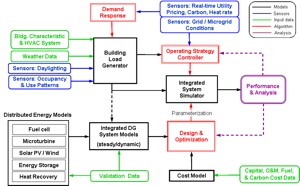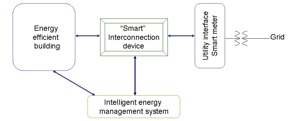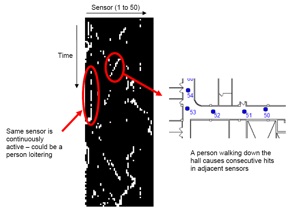Cyber-Enabled Efficient
Energy Management of Structures (CEEMS)
Cyber-Enabled Efficient
Energy Management of Structures (CEEMS)
The CEEMS project involves several interrelated projects that reflect a view of a building as a set of overlapping, interacting networks. These networks include the thermal network of the physical building, the energy distribution network, the sensing and control network, as well as the human network, which in the past have been considered only separately.
Integrated Systems Modeling, Simulation, Design and Optimization
In the face of looming energy and environmental challenges there is increasing interest to both retrofit existing and build new building structures with low- and zero-energy performance characteristics]. To achieve maximum energy efficiency, a whole-building perspective is needed that integrates sensors, controls, distributed resources, and communications to anticipate changes in the environment and respond dynamically while maintaining comfort, efficiency, and air quality.
This project will develop a generalized framework that enables exploration of optimal systems-integration and control of such advanced technologies in building applications.

Control of Smart Interface Devices and Efficient Interfacing with the Electric Grid
The subject of this thrust area will be the development of an intelligent energy management (IEM) system, which coordinates the control and operation of the electric energy network within the energy efficient building. This can include the control of distributed generation sources as well as energy storage mechanisms. The IEM is also envisioned to provide a user-friendly human interface to the building user for making the structure customer-driven from the perspective of the electricity markets. A cyber-enabled control methodology using multi-agent systems for efficient
utilization of electricity is being proposed here as a tool for realizing this concept. The IEM will function as the cyber-enabled controller for the electrical system of the energy efficient building.

Activity recognition and prediction
A key aspect of cyber-physical systems is the interaction of that system with humans. This is highlighted in the case of buildings. The operation of the heating and cooling systems of a building depend on the activities of the occupants.
Acceptable temperature profiles depend on when and where people are occupying the building, while at the same time, the presence of people affects the energy flow in the building. This project will develop methods to model (and predict) the activities of people that are relevant to energy management. This information is key both for accurate simulation of the energy flow in buildings, as well as for efficient control of that energy flow.

Algorithms for Identification of Interconnected Systems
System modeling serves as a foundation for the design and implementation of real time prediction and control of heterogeneous networks. However, because of the computational requirements of real-time operation, these models need to be parsimonious. In addition, there may be aspects of actual implementations that are unknown at the time of design, or that vary with time as aspects of the system change (e.g. aging or re-configuration).
This project will seek to develop methodologies that can link physical and signal flow structures, and through this understand issues of importance to system identification of heterogenous networks, including sensor selection and placement, and sufficiency of excitation.
Decision and Control for Interconnected Systems
Distributed systems are a current active area of research within the field of control systems. By distributed system, we mean one with a large number of inputs and outputs and a possibly decentralized decision and control architecture, with restrictions on communication between computational nodes. However, the current state of the art has focused primarily on homogeneous systems. A cyber-physical system may be viewed as a composite system where a physical process (such as a building) has been augmented with a hardware infrastructure (sensors and actuators) and a cyber-infrastructure (communication and decision nodes). Such overlaid heterogeneous systems with constrained connectivity and interaction between the different layers presents challenges and opportunities for system optimization and control. This project will develop ways to reason about both discrete, multi-attribute heterogeneous entities and continuous, heterogeneous processes operating on a hierarchy of layered graphs that are related to each other through a set of mappings or transformations.


Any opinions, findings, and conclusions or recommendations expressed in this material are those of the author(s) and do not necessarily reflect the views of the National Science Foundation.